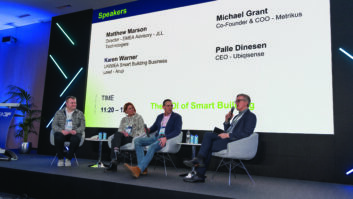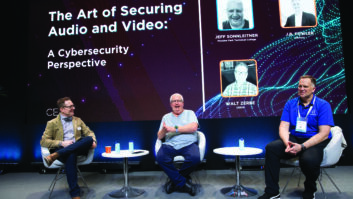
Is it an attractive, accessible location? What kind of meeting spaces does it offer? Is the catering of high quality? Those are three questions a conference organiser will likely be asking about a prospective venue. But, if the websites of the highest profile conference centres around Europe are anything to go by, that organiser will also be considering the quality of the AV facilities.
“With a selection of 4K, UHD and HD screen options throughout the venue, we offer you huge flexibility and the very latest AV technology,” claims the Church House Conference Centre in Westminster. At the NH Collection Madrid European Building, you can avail yourself of “32 naturally-lit function rooms with world class audiovisual technology”. The Berlin Marriott Hotel urges conference organisers to “select one of our meeting rooms with state-of-the-art audiovisual services”.
Competitive advantage
“Investment in technology is seen as a method to create competitive advantage,” believes Andy Truswell, systems integration manager at integrator Pure Audio Visual. “The change is driven in part by the expectations of clientele, and in part by the need to compete with other local venues. It offers the conference centre a sales tool to differentiate itself from the competition.”
“Aging technology and increasing competition are some of the reasons why there has been a big increase in conferencing centres receiving a technology makeover,” adds Christian Czimny, European R&D director at Absen.
“From smaller meeting rooms to conferencing suites that can house international meetings, conference centres have to cater for a range of business needs, with AV technology providing the backbone to this offering,” says Lucy Meredith, regional marketing manager, Panasonic Visual Solutions. “Not only are conference centres delivering more, but their customers also expect more.”
“Conference centres are being tasked to cope with multiple format types delivered on multiple media types,” notes Eliot Fulton-Langley, solutions architect at integrator CDEC. “As there is so much choice for content type and method of delivery, it is not necessarily good enough for a conference centre to be specific to their customers about the parameters of the content, which in turn makes their work harder to be able to handle it.”
“Conference centres need to be chameleons, changing and adapting dependent on the audience and content requirements”
Carl Standertskjold, Sony
Perfect storm
It is, then, something of a perfect storm: an increasingly competitive market; a broad range of requirements that need to be catered for; a generational change in technology – and an increasingly sophisticated, savvy customer. The stakes are high when it comes to conference centres making the right decisions to ensure they too can offer “the very latest”, “world class” or “state-of-the-art” when it comes to putting images on screens in conference centres.
“Projection remains the standard for delivering video and images in conference centres today, and that’s mainly due to the flexibility projection offers,” says Carl Standertskjold, corporate segment marketing manager at Sony. “Conference centres need to be chameleons, changing and adapting dependent on the audience and content requirements. Projection offers a straightforward and flexible solution that can be adapted rapidly to each client’s requirement.”
“Projection is still very much the main cost-effective medium for getting content onto screens,” echoes Colin Etchells, who is group technical director at integrator Visavvi. “Performance is increasing with the advent of laser light engines and superior optics, coupled with enhanced resolutions such as 4K starting to become more prevalent as well as affordable.”
“LED wall is currently only a tiny percentage of the market, mostly due to the still significant price difference,” he continues. “LED resolution has matured, with sub 1.0mm pitch now appearing; however, this high detail still comes at a price premium – making it unrealistic for many venues presently.”
Growth unabated
“For conference centre AV, a front projection solution is still the lowest cost option to enable a large screen to feature in this environment,” agrees Steve Scorse, vice president, Unilumin Group. “However, the growth of LED videowalls over projectors in conference and event centres continues unabated. The continued reduction in LED display costs has opened the technology as a possibility for many customers.”
Unsurprisingly, he has an ally in Czimny. “In terms of delivering video/images, with the introduction of fine pixel pitch products – at 2mm and sub-2mm – there has been a distinct move to LED away from technologies such as projection and LCD/flat panel videowalls,” he says. “With the increase in LED manufacturing volumes and subsequent reduction in price, LED now offers a genuine alternative to these other technologies, bringing the added benefits of higher brightness, longer lifetime, easier maintenance, greater flexibility of configuration and a lower TCO.”
Size matters
As much as budget is a factor, one of the factors most likely to determine how images are delivered is the size of the space – a point made by Holger Graeff, general manager at Vivitek EMEA.
“When it comes to meeting the needs of a very large sized room, with a very large image – 500in for example – it is easier to achieve this using a projector rather than a videowall, and most cost-effective. In terms of a big room’s dynamics, it is important to have a screen that’s big enough for the audience at the back of the room to still see the content being shown at the front.”
“It’s fair to say that size matters in large conference rooms,” he smiles.
The other factor, as Meredith points out, is ambient lighting. “Conferences are often held in well-lit spaces, so it’s important that any projection is high in brightness to cut through any ambient light and ensure visibility for attendees,” she points out.
Scorse sees a similar issue – but proposes an alternative solution. “Lighting conditions for the best image quality using a projector will demand that ambient lighting in the auditorium is somewhat subdued, due to the screen contrast being adversely affected,” he explains. “Videowalls provide improved brightness and contrast, and allow higher ambient lighting conditions in the facility to be operated.”
www.absen.com
www.cdec.co.uk
www.panasonic.com
www.pureav.co.uk
www.pro.sony
www.unilumin.com
www.visavvi.com
www.vivitek.eu







